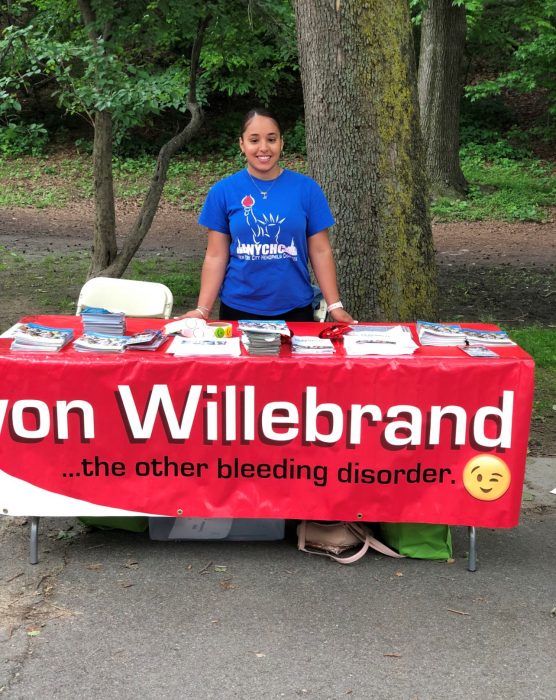‘Put Your Oxygen Mask on First:’ How to Prioritize Your Health With Von Willebrand Disease
It’s never a good time to find out you have a rare disease, but discovering there’s something “different” about you in high school can be especially challenging. I was 16 years old when I was diagnosed with von Willebrand disease (VWD), a rare bleeding disorder caused by either a low level of a specific clotting factor or caused by that specific clotting factor not working properly. The clotting factor is called von Willebrand factor or VWF.
I remember that year’s Valentine’s Day clearly, when my period resulted in a huge blood clot and a trip to the emergency room. Heavy menstrual bleeding – bleeding for more than 7 days, changing a tampon or pad every 2 hours or less, and passing blood clots larger than a quarter – is common for women with VWD.1 I was used to heavy bleeding and painful cramping during my cycle, but I’d never experienced a clot like that. I knew it wasn’t what would be considered normal and acted quickly to get the medical support I needed.
I feel lucky that my doctors knew to test me for VWD and that I received my diagnosis rather quickly. Many women with VWD face a long road to diagnosis – an average of 16 years from their initial symptoms to accurate diagnosis.2
But my VWD journey didn’t stop there. After additional tests, my doctors said my case of VWD was more severe and referred me to a hematologist for further care. I feel like that’s where my story begins.
I didn’t understand what was going on with my body. The information available felt very textbook. It didn’t help me understand how VWD was going to affect my life and why the lifestyle changes I was encouraged to make were so important. I wanted to play sports or go to the gym, not travel 2-3 hours to a “VWD-friendly” infusion center for treatment.
To top it all off, I kept being told my symptoms were more of a gynecological issue than VWD. I was prescribed oral contraception and, for a while, my menstrual bleeding seemed under control. But I was still having nosebleeds.
With time, my bleeding episodes became more severe. I had up to 19 nosebleeds a day and was hospitalized regularly for heavy menstrual bleeding and severe cramps, which impacted my ability to go to nursing school. So, I went back to my home hospital in New York City.
There I saw an incredible doctor about my case. He listened to the symptoms I was experiencing and the factors that were important to me when choosing a care plan, like being able to self-infuse when I had no access to an infusion center and the desire to have a family one day. I felt seen, heard and important for the first time in my VWD journey.
My doctor recommended I try VONVENDI® [von Willebrand factor (Recombinant)], a medicine used to treat and control bleeding episodes in adults (18 years and older) with VWD. My doctor said that I shouldn’t take VONVENDI if I’m allergic to mice, hamsters, or any ingredients in VONVENDI. He also explained that severe allergic reactions to VONVENDI can happen including: rash or hives, itching, tightness of the throat, chest pain or tightness, difficulty breathing, lightheadedness, dizziness, nausea or fainting. My doctor also explained that the most common side effects for VONVENDI include generalized itching, vomiting, nausea, dizziness, joint pain, joint injury, increased liver enzyme level in blood, and vertigo.
He explained that VONVENDI is infused into my blood stream, where it acts like my body’s natural von Willebrand factor (a clotting protein), helping to form clots and helping my own factor VIII (another clotting protein) to work.3 He also explained that many learn to infuse VONVENDI by themselves or with the help of a family member, and that I needed to be trained by a healthcare provider or hemophilia treatment center before infusing at home.
Scroll below for additional Indications and Important Risk Information. Please see VONVENDI full Prescribing Information and discuss with your doctor.
My experience so far has been positive. Since using VONVENDI on-demand, I infuse twice daily on days when I have bleeds and the amount of times I’ve needed to be hospitalized for bleeding episodes decreased. That’s just my experience though. Every VWD patient is different and should talk to their doctor about what treatment option is best for them.
My relationship with my VWD has changed drastically. I’ve learned that when living with a rare disease, you have to “put your own oxygen mask on first.” I listen to my body and advocate for what I need, which has made me feel empowered in my health journey. Sometimes that can be difficult with family and friends, but the more they know about what I’m going through, the easier it is to navigate life with VWD.
If you are living with VWD, I encourage you to never give up. You’re not alone. There are great resources available now to help you on your journey, like the National Hemophilia Foundation, local chapters and online communities.
Living with VWD can be incredibly challenging, and it’s not something that’s going to disappear. But I’m prepared for whatever will come my way.
Visit Vonvendi.com to hear more stories like mine and learn about other patient resources.

*Nicole A. is a paid contributor for Takeda. Last name withheld to protect subject’s privacy.
VONVENDI® [von Willebrand factor (Recombinant)] Important Information
What is VONVENDI?
VONVENDI is used in adults (age 18 years and older) diagnosed with von Willebrand disease to:
-
- treat and control bleeding episodes
- prevent excessive bleeding during and after surgery
- reduce the number of bleeding episodes when used regularly (prophylaxis) in adults with severe Type 3 von Willebrand disease receiving on-demand therapy
Detailed Important Risk Information
Who should not use VONVENDI?
You should not use VONVENDI if you:
-
- Are allergic to any ingredients in VONVENDI.
- Are allergic to mice or hamsters.
Tell your healthcare provider if you are pregnant or breastfeeding because VONVENDI may not be right for you.
How should I use VONVENDI?
Your first dose of VONVENDI for each bleeding episode may be administered with a recombinant factor VIII as instructed by your healthcare provider.
Your healthcare provider will instruct you whether additional doses of VONVENDI with or without recombinant factor VIII are needed.
What should I tell my healthcare provider before I use VONVENDI?
You should tell your healthcare provider if you:
-
- Have or have had any medical problems.
- Take any medicines, including prescription and non-prescription medicines, such as over-the-counter medicines, supplements or herbal remedies.
- Have any allergies, including allergies to mice or hamsters.
- Are breastfeeding. It is not known if VONVENDI passes into your milk and if it can harm your baby.
- Are pregnant or planning to become pregnant. It is not known if VONVENDI can harm your unborn baby.
- Have been told that you have inhibitors to von Willebrand factor (because VONVENDI may not work for you).
- Have been told that you have inhibitors to blood coagulation factor VIII.
What else should I know about VONVENDI and von Willebrand Disease?
Your body can form inhibitors to von Willebrand factor or factor VIII. An inhibitor is part of the body’s normal defense system. If you form inhibitors, it may stop VONVENDI or factor VIII from working properly. Consult with your healthcare provider to make sure you are carefully monitored with blood tests for the development of inhibitors to von Willebrand factor or factor VIII.
What are the possible side effects of VONVENDI?
You can have an allergic reaction to VONVENDI.
Call your healthcare provider right away and stop treatment if you get a rash or hives, itching, tightness of the throat, chest pain or tightness, difficulty breathing, lightheadedness, dizziness, nausea or fainting.
Side effects that have been reported with VONVENDI include: headache, nausea, vomiting, tingling or burning at infusion site, chest discomfort, dizziness, joint pain, joint injury, increased liver enzyme level in blood, hot flashes, itching, high blood pressure, muscle twitching, unusual taste, blood clots and increased heart rate.
Tell your healthcare provider about any side effects that bother you or do not go away.
You are encouraged to report negative side effects of prescription drugs to the FDA. Visit www.fda.gov/medwatch, or call 1-800-FDA-1088.
Please see VONVENDI full Prescribing Information.
References
- What is von Willebrand disease? Centers for Disease Control and Prevention website. Accessed July 9, 2020. http://www.cdc.gov/ncbddd/vwd/facts.html.
- Kirtava A, Crudder S, Dilley A, Lally C, Evatt B. Trends in clinical management of women with von Willebrand disease: a survey of 75 women enrolled in haemophilia treatment centres in the United States. Haemophilia. 2004;10(2):158-61.
- VONVENDI Prescribing Information.
©2023 Takeda Pharmaceuticals U.S.A., Inc., 300 Shire Way, Lexington, MA 02421. 1-877-TAKEDA-7 (1-877-825-3327). All rights reserved. TAKEDA and the TAKEDA logo are trademarks or registered trademarks of Takeda Pharmaceutical Company Limited. VONVENDI is a registered trademark of Baxalta Incorporated, a Takeda company.
US-VON-0769v1.0 03/23


